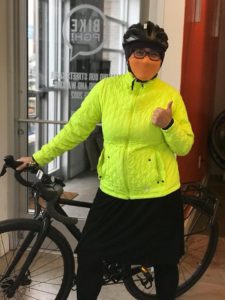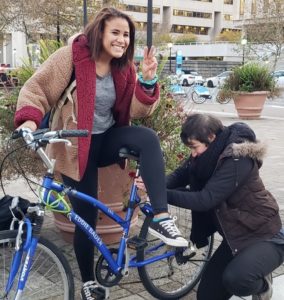
How to Survive Frigid Pittsburgh Winters on Two Wheels
Fall quickly came and left. With the arrival of winter, it doesn’t mean you have to stop riding your bike! Recently BikePGH’s Women and Non Binary Program had a Winter What to Wear Event to discuss all the tips and tricks of winter riding. Here’s a recap of helpful tips, with extra thanks to our guest presenter, Kat Gregor, an avid winter cyclists:
Clothing and Body Care
To best prepare for the cold rides through winter, layering will be your friend. Kat, and other winter bike commuters, highly recommend merino wool as a base layer. Traditional cotton base layers absorb the sweat and becomes wet, thus making you more cold. Merino wool doesn’t have that issue, so it will absorb the seat without becoming wet and further keep you insulated. It can be worn as a shirt, cap, or socks. To build upon your base layer, Kat suggests that a waterproof outer shell for the impromptu Pittsburgh rain. A rain jacket or poncho can keep you dry! They can easily be stored in a carrier bag on your bike.

Hands, feet, and extremities are necessary to keep warm but are also the hardest! For hands, consider using the layer technique. Have an inside layer with solar gloves or smart wool gloves, then use a small hand warmer packet to place on top of the inside layer, and, finally, have an outer shell glove to place it all in to! For feet, consider a thin pair of merino wool socks, then neoprene toe covers, and, finally, a thicker pair of socks before placing them in your waterproof shoe. Shoe choice can be especially helpful in keeping your feet warm. Boots and shoes make all the difference, so ensure your shoes have traction to not slip off wet pedals! You can also look into getting Over Shoes… Kat suggests these.
Don’t neglect your head, face, and neck when preparing for your commute. Wearing two scarves or a balaclava will keep your face and neck warm! If wearing two scarves, wear a small beanie or merino wool cap underneath your helmet to retain the heat. Most importantly, keep your eyes protected with goggles or glasses! This will help with not only eye comfort, but with seeing during varying weather (sun glare, rain, sleet, and snow).
Keep in touch with your body care. Don’t forget to use SPF and a moisturizer to keep your skin protected and hydrated. SPF will stop sunburn, even in conditions where it doesn’t seem like it could be a possibility (cloudburn is real!). Shea butter is an environmentally friendly, natural hydrating thick moisturizer to help with windburn.
Outfitting your bike
The most important gadget for your bike is lights. Make sure you are visible to drivers and riders around you! It is PA State Law to have a front light and rear reflector after dark (we recommend an additional rear light). Popular types of lights are spoke lights, headlamps, front lights, and rear bike lights. Test them ahead of time by grabbing a friend, going for a spin, and having them check if they can see you in the dark. Another way to improve your visibility is to get reflectors! They can be a slap on wrist/ ankle bands or have a jacket with them on the sleeves. Reflector stickers can be placed on your helmet or bike to improve visibility.

To make your bike more winter proof, consider if different tires are needed for the weather conditions. Winter tires can help deal with frequent ice patches. Wide tires (41 mm), knobby tread, or mountain tires could be your friend! You should practice with your new tires before the weather gets bad. Additionally, fenders can be a great improvement to your bike to help keep slush off your pants.
To stay warm and dry, bar mitts will keep your hands from wind and wet conditions. Bar mitts can be used for any type of handle bars!
Also, when parking your bike outside, using a plastic bag to protect the seat will keep it dry until you need to commute again. A poncho, plastic reusable bag, shower cap, or garbage bag will do.
Commuter Safety and Route Selection
Winter road conditions can cause for unsafe riding if adequate preparation isn’t taken. Consider if you need a different “winter route” than your “summer route”, as your summer route might not be as winter ready for your commute. Plan the night before, and stick to main roads as they may be a better route option if they get cleared first! Think about your safety and carry a connect card or cash/coins for buses.

Or, plan a backup ride option, if available. If not, look along your route for places to stop in if the weather is too much. Your local bike shops might be a good first look! If you can, use your day off to practice your new route.
If you feel unsafe due to ice or snow piled up on the right-most part of the road, take the lane! You are allowed to take the lane and are a legitimate road user while riding a bike. Make the safest choice for your commute, and ride in the safest right-most tread line. Find a friend or co-worker to commute with. Riders are safer in numbers. Also, let someone know where and when you’re riding as safety measure
Here are some resources can help you check weather and road conditions:
- The BikePGH Message board has a yearly thread about weather and road conditions/hazards to warn one another
- REPORT: 311 – a resource to deal with: potholes, crooked signs, faded lanes
Overall Health and Wellness
It is okay to not ride everyday, know your body, take a break! Some days it may be better to take the bus, or other transportation, to give your body a rest. To help ease your muscles of riding, stretch when you can: in the morning, post-ride, or when you get home. Bicycling magazine has videos for neck stretches (& more) geared toward cyclists. It can help getting into a routine.
If you’re feeling a bit down, not only exercise will help but vitamins and minerals as well. Consider checking with your doctor on your mineral levels. A 10k lux lamp may also be an SAD-defeating avenue for you, however, be intentional with it as it is a real therapeutic option.
2 Comments
Hi, I’m curious about the image above with the woman wearing a black helmet and bright yellow jacket. Specifically, I’ve tried to wear a face mask like she has on but it fogs up my glasses. Particularly when stopped for a traffic light. I’m curious how she avoids that problem. Thanks!
Hi, the trick that I’ve found is to make sure that the face mask is tightly tucked under your glasses. Also, breathing almost like you’re whistling helps too, if you can do that.